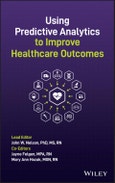Winner of the American Journal of Nursing (AJN) Informatics Book of the Year Award 2021!
Discover a comprehensive overview, from established leaders in the field, of how to use predictive analytics and other analytic methods for healthcare quality improvement.
Using Predictive Analytics to Improve Healthcare Outcomes delivers a 16-step process to use predictive analytics to improve operations in the complex industry of healthcare. The book includes numerous case studies that make use of predictive analytics and other mathematical methodologies to save money and improve patient outcomes. The book is organized as a “how-to” manual, showing how to use existing theory and tools to achieve desired positive outcomes.
You will learn how your organization can use predictive analytics to identify the most impactful operational interventions before changing operations. This includes:
- A thorough introduction to data, caring theory, Relationship-Based Care®, the Caring Behaviors Assurance System©, and healthcare operations, including how to build a measurement model and improve organizational outcomes.
- An exploration of analytics in action, including comprehensive case studies on patient falls, palliative care, infection reduction, reducing rates of readmission for heart failure, and more - all resulting in action plans allowing clinicians to make changes that have been proven in advance to result in positive outcomes.
- Discussions of how to refine quality improvement initiatives, including the use of “comfort” as a construct to illustrate the importance of solid theory and good measurement in adequate pain management.
- An examination of international organizations using analytics to improve operations within cultural context.
Using Predictive Analytics to Improve Healthcare Outcomes is perfect for executives, researchers, and quality improvement staff at healthcare organizations, as well as educators teaching mathematics, data science, or quality improvement. Employ this valuable resource that walks you through the steps of managing and optimizing outcomes in your clinical care operations.
Table of Contents
Contributors xi
Foreword xv
Preface: Bringing the Science of Winning to Healthcare xvii
List of Acronyms xix
Acknowledgments xxv
Section One Data, Theory, Operations, and Leadership 1
1 Using Predictive Analytics to Move from Reactive to Proactive Management of Outcomes 3
John W. Nelson
2 Advancing a New Paradigm of Caring Theory 19
John W. Nelson and Jayne Felgen
3 Cultivating a Better Data Process for More Relevant Operational Insight 33
Mary Ann Hozak
4 Leadership for Improved Healthcare Outcomes 43
Linda Valentino and Mary Ann Hozak
Section Two Analytics in Action 53
5 Using Predictive Analytics to Reduce Patient Falls 55
Tara Nichols, Lance Podsiad, Josephine Sclafani Wahl, and John W. Nelson
6 Using the Profile of Caring® to Improve Safety Outcomes 67
John W. Nelson and Kenneth Oja
7 Forecasting Patient Experience: Enhanced Insight Beyond HCAHPS Scores 83
Mary Ann Hozak and John W. Nelson
8 Analyzing a Hospital-Based Palliative Care Program to Reduce Length of Stay 93
Kate Aberger, Anna Trtchounian, Inge DiPasquale, and John W. Nelson
9 Determining Profiles of Risk to Reduce Early Readmissions Due to Heart Failure 103
Mary Ann Hozak, Melissa D’Mello, and John W. Nelson
10 Measuring What Matters in a Multi-Institutional Healthcare System 125
Kay Takes, Patricia Thomas, Gay Landstrom, and John W. Nelson
11 Pause and Flow: Using Physics to Improve the Efficiency of Workflow 135
Jacklyn Whitaker, Benson Kahiu, Marissa Manhart, Mary Ann Hozak, and John W. Nelson
12 Lessons Learned While Pursuing CLABSI Reduction 153
Ana Esteban, Sebin Vadasserril, Marissa Manhart, Mary Ann Hozak, and John W. Nelson
Section Three Refining Theories to Improve Measurement 169
13 Theory and Model Development to Address Pain Relief by Improving Comfort 171
Tara Nichols and John W. Nelson
14 Theory and Model Development to Improve Recovery from Opioid Use Disorder 183
Alicia House, Kary Gillenwaters, Tara Nichols, Rebecca Smith,and John W. Nelson
Section Four International Models to Study Constructs Globally 197
15 Launching an International Trajectory of Research in Nurse Job Satisfaction, Starting in Jamaica 199
John W. Nelson and Pauline Anderson-Johnson
16 Testing an International Model of Nurse Job Satisfaction to Support the Quadruple Aim 217
John W. Nelson, Patricia Thomas, Dawna Cato, Sebahat Gözüm, Kenneth Oja, Sally Dampier, Dawna Maria Perry, Karen Poole, Alba Barros, Lidia Guandalini, Ayla Kaya, Michal Itzhaki, Irit Gantz, Theresa Williamson, and Dominika Vrbnjak
17 Developing a Customized Instrument to Measure Caring and Quality in Western Scotland 237
Theresa Williamson, Susan Smith, Jacqueline Brown, and John W. Nelson
18 Measuring the Effectiveness of a Care Delivery Model in Western Scotland 259
Theresa Williamson, Susan Smith, Jacqueline Brown, and John W. Nelson
Epilogue: Imagining What is Possible 287
Appendix 291
References 409
Index 427








